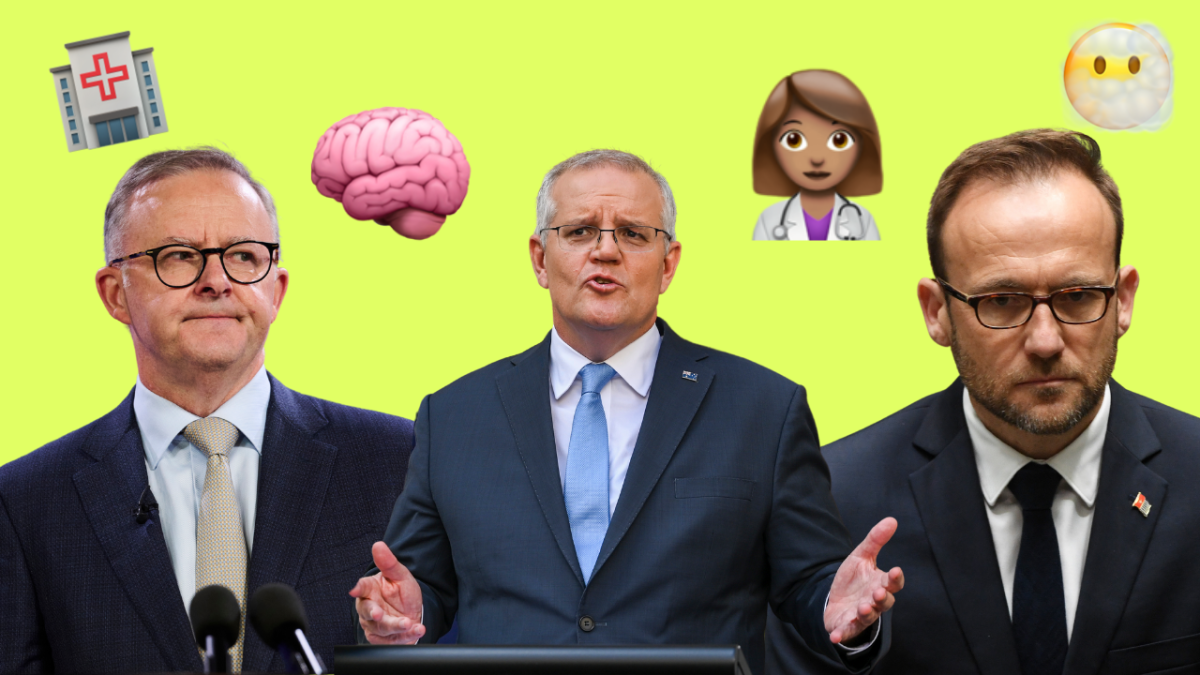
The countdown to election day is on and because the Coalition’s held power for almost a decade, this is Australia’s big chance for change. So we’re here to help you understand and compare each major party’s mental health policies and lay it all out without the political spin.
NOTE: promises are often broken so we’ve also prepared a little look back at the voting track records of Scott Morrison, Anthony Albanese and Adam Bandt — because what they do speaks louder than their words.
We’ll compare the Coalition, Labor and the Greens’ policies on all the issues important to young people.
We’ve narrowed them down to: climate change, the cost of living and housing, women’s rights, LGBTQIA+ rights, First Nations rights, mental health and education.
Now it’s time for mental health.
We know mental health among young Australians is in the fkn toilet, especially since the pandemic. At least one in four young people aged 16 to 24 thought about suicide over the past two years, 15 per cent attempted self-harm, 72 per cent reported symptoms of anxiety and 62 per cent reported depression. This compared to just 49 per cent of adults aged 25 or higher who reported any mental health issues at all during the pandemic.
Needless to say we are ALL EARS.
The Coalition’s Mental Health Policy
The Coalition has committed $547 million to mental health services over the next five years on top of the $2.3 billion it pledged for the same time period in the 2012-22 federal budget.
It would go towards expanding front line services for people with severe and complex mental illnesses and suicide prevention. Headspace would also receive $14.8 million over the next four years and the total number of its services across Australia will be expanded.
Lifeline, Beyond Blue, ReachOut, Kids Helpline and the Butterfly Foundation would also get more funding. Lifeline would get the most at $52.3 million.
There’s also a specific investment in mental health support for multicultural communities including $17.8 million for cultural and linguistically diverse communities and refugees to access mental health care.
Another $8.5 million would go to the Red Dust Program which provides mental health support in remote Northern Territory communities, focused on social and emotional wellbeing, relationships, alcohol and other drugs and Foetal Alcohol Spectrum Disorder (FASD).
All in all this is pretty good but most of this money is a continuation of previous funding so it’s sort of a given.
Labor’s Mental Health Policy
Labor on the other hand has been surprisingly silent on the issue of mental health given its prominence in our lives. It’s campaigned hard on promises of giving a huge boost to Medicare but hasn’t spent much time talking specifically about mental health.
If elected it would however restore telehealth psychiatric consultations for people living in regional and rural Australia — which the government cut during the pandemic — by committing to cover 50 per cent of the cost of non-bulk billed regional telehealth psychiatry sessions through Medicare.
It has also pledged $440 million to increase support for student mental health in public schools with more counsellors and psychologists (as well as funding better ventilation systems to prevent the spread of airborne diseases).
That’s about it though.
The Greens’ Mental Health Policy
Heeeeere we go. The Greens want to invest $4.8 billion to fully fund mental health services under Medicare. That means you’d be able to get unlimited sessions with a bulk-billed psychologist or psychiatrist with no out-of-pocket fees.
‘Nuff said.
It’d also invest $2.5 billion to implement a national rollout of the Individual Placement and Support program which is designed to help young people impacted by poor mental health find stable work. And it would create jobs for another 1,000 peer workers (someone who uses their lived experience with poor mental health for example, alcohol dependancy, to counsel or coach sufferers).



